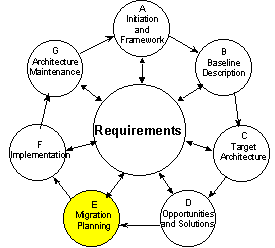 Objective
ObjectiveObjective Approach Inputs Steps Outputs
 Objective
ObjectiveThe objective of this phase is to sort the various implementation projects into priority order. Activities include assessing the dependencies, costs and benefits of the various migration projects. The prioritized list of projects will go on to form the basis of the implementation plan.
There are some important questions to be asked before embarking on a migration exercise:
Many things affect the answers to these questions, including the current and future architectures, the size of the organization and its complexity, and the value of technology to the core functions of the organization. Other things to consider are the asset value of the current systems, and the level of risk associated with changing the solution and/or the supplier.
Most organizations find a change of architecture has too much impact on the organization to be undertaken in a single phase. Migration often requires consideration of a number of technical issues, not the least of which are associated with the means of introducing change to operational systems.
Issues requiring special consideration may include:
The decisions resulting from these considerations should be incorporated in the implementation plan.
The Migration Planning phase allows the individual projects or work packages to be sorted into a series of plateaus, each of which can be achieved in a realistic time scale.
Inputs to this phase are:
Key steps in this phase include:
The output of this phase is:
Copyright © The Open Group, 1998, 1999, 2000